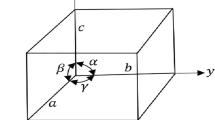Abstract
Using a method used mainly by geophysicists for small specimens-acousticresonance spectroscopy (ARS)-we measured the elastic-stiffness constants of centimeter-size copper specimens with rectangular-parallelepiped shapes. The polycrystal consisted of heavily twinned 75-μm crystallites. From the specimens' macroscopic resonance-vibration frequencies (midkilohertz to low-megahertz), we calculated the least-squares elastic-stiffness coefficients, two and three for the two cases. Using the same specimens, we augmented the ARS measurements with conventional pulse-echo-method measurements. Using rod specimens, we measured the Young modulus E and torsional modulus G, and we calculated the bulk modulus B. The less direct and less familiar ARS method gives the same results as a usual pulse-echo method and a rod-resonance method. The small difference between polycrystal and monocrystal values may arise from mobile twin boundaries that contribute a small reversible plastic strain to the intrinsic elastic strain. We list 16 advantages of the ARS method to measure elastic constants.
Similar content being viewed by others
References
H. Regnault,Annal. Chim. Phys. 4:64 (1842).
G. Wertheim,Annal. Chim. Phys. 23:52 (1848).
E. Amagat,C.R. Acad. Sci. Paris 99:130 (1884).
P. Bridgman,The Physics of High Pressure (Bell, London, 1952).
P. Bridgman,Am. Acad. Arts Sci. Proc. 58:165 (1923).
P. Bridgman,Am. Acad. Arts Sci. Proc. 77:187 (1949).
C. Swenson,Solid State Phys. 11:41 (1960).
E. Schreiber, O. Anderson, and N. Soga,Elastic Constants and Their Measurement (McGraw-Hill, New York, 1973).
D. Lazarus,Phys. Rev. 76:545 (1949).
E. Goens and J. Weerts,Phys. Z. 37:321 (1936).
H. Dernarest,J. Acoust. Soc. Am. 49:768 (1969)
H. Ledbetter, N. Frederick, and M. Austin,J. Appl. Phys. 51:305 (1980).
H. Ledbetter,Cryogenics 20:637 (1980)
P. Heyliger, A. Jilani, H. Ledbetter, R. Leisure, and C.-L. Wang.J. Acoust. Soc. Am. 94:1482 (1993)
H. Ledbetter and E. Naimon,J. Phys. Chem. Ref Data 3:897 (1974).
O. Anderson,J. Acoust. Soc. Am. 91:2245 (1992)
M. Lei, J. Sarrao, W. Visscher, T. Bell, J. Thompson, and A. Migliori,Phys. Rev. B 47:6154 (1993).
Author information
Authors and Affiliations
Rights and permissions
About this article
Cite this article
Ledbetter, H., Kim, S., Fortunko, C. et al. Compressibility of polycrystal and monocrystal copper: Acoustic-resonance spectroscopy. Int J Thermophys 17, 263–269 (1996). https://doi.org/10.1007/BF01448228
Issue Date:
DOI: https://doi.org/10.1007/BF01448228




